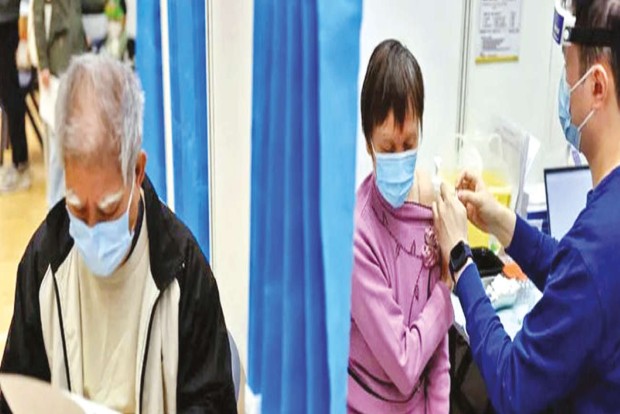Covid-19 has surged in a number of Asian countries that had once held the virus at bay. Vaccination levels have largely determined how deadly those waves would be
The first time the Omicron variant breached Hong Kong’s coronavirus defences in late 2021, the city stamped it out, cementing its status as one of the world’s most formidable redoubts of “zero COVID”. But a few weeks later, Omicron came to the metropolis again, this time causing an outbreak among cleaners at a public-housing estate that spiralled out of control. The conflagration of resulting cases is now killing people at a rate exceeding that of almost any country since the coronavirus emerged.
Over the entire pandemic, Hong Kong’s death toll per capita, once far lower than those of Western nations, is no longer exceptional. A month ago, the US’s COVID deaths were 90 times as that of Hong Kong. By Monday, the cumulative American toll was three and a half times as high.
As the US braces for a less punishing rise in cases and mainland China battles its biggest outbreak in two years, scientists have looked to Hong Kong for clues about the threat Omicron poses in an entirely different setting: a dense city where people were not only largely untouched by previous infections, but whose oldest and most vulnerable residents were also largely unvaccinated.
Several critical lessons emerged, health experts said. In the era of Omicron and its even more infectious sub-variant, BA.2, vaccinating a broad swath of the population remained important, scientists said. But inoculating as many older people as possible had become far and away the top priority.
That message, they said, was most pressing for China, where vaccinations in older age groups appear to be lagging. It was relevant again in the United States, too, where subpar vaccination and booster rates among older people have left scientists concerned about a potential surge of BA.2 cases. Partly because so many more Americans have been infected and killed by the coronavirus during earlier waves, scientists do not expect the US to face as serious a situation as Hong Kong.
Hong Kong’s dreadful outbreak also signals the perils of trying to eliminate the virus without a plan for what would come next, health experts said, noting that Omicron’s high transmissibility made outbreaks almost inevitable.
Hong Kong, which along with mainland China had been among the last holdouts of a strategy of tight restrictions and border controls, was left vulnerable by how few of its residents had any immunity from prior infections: Before the Omicron surge, only about 1 per cent of its population had contracted the virus.
Those low levels of immunity can leave places vulnerable to waves, as more contagious variants sneak in or restrictions are lifted. But governments can still prepare for those waves, said Dr Gabriel Leung, dean of medicine, University of Hong Kong.
Less than one-quarter of people aged 80 and above in Hong Kong had been given two doses of a vaccine before Omicron surged, compared with more than 90 per cent in Singapore and New Zealand.
Because of the number of unvaccinated older people in China, scientists said, it might also have some difficulty lifting “zero COVID” restrictions. More than 87 per cent of China’s population have been vaccinated. But just over half of people 80 and older have had two shots, and less than 20 per cent of people in that age group have received a booster, said Zeng Yixin, a vice minister of the National Health Commission.
“I don’t think it’s quite ready for the transition,” Dr Leung said.
A number of Asian and Pacific countries had largely kept the virus at bay for two years, only to face Omicron outbreaks because it was so contagious and their populations had avoided earlier infections. But high vaccination rates, including among older people, have helped many of those countries avoid more devastating surges.
In South Korea, for example, where 87 per cent of people are vaccinated and 63 per cent have booster shots, the cumulative death toll per capita is one-tenth of America’s, even though South Korea has recorded more than three-quarters as many cases as the US.
Health experts said Hong Kong’s difficulties vaccinating older people resulted from a combination of complacency and unfounded fears that older people and those in poor health faced risks from vaccines. The city has vaccinated only 39 per cent of residents aged 80 and above, despite having inoculated almost two-thirds of 12- to 19-year-olds.
Many people in Hong Kong have been given the Chinese vaccine Sinovac, which appears to offer relatively little protection from Omicron infections but a better defence against severe disease. Scientists noted that almost 90 per cent of people who died during the latest wave were not fully vaccinated, suggesting that getting shots to the most vulnerable is more important than the particular brand.
“The problem in Hong Kong is, we haven’t succeeded in vaccinating our most vulnerable population — the elderly, especially those staying in elderly-care homes,” said Dr Siddharth Sridhar, a clinical virologist at the University of Hong Kong. “And as a result, we are in a very bad situation.”
The US has vaccinated many more of its older residents than Hong Kong but fewer than Western Europe and has seen a high death rate. As immunity from early vaccinations wanes and booster shots become critical for shoring up protection against Omicron among older people, the US finds itself exposed on that count, too. About 41 per cent of people 65 and over have not received a booster shot.
Unlike other parts of Asia that had gradually lifted restrictions in recent months, Hong Kong was not ready for its defences to fail, scientists said. “From the government’s point of view, there was such a strong fixation on ‘zero COVID’ that as long as that worked, vaccination was not necessarily the priority,” said Ben Cowling, a professor of epidemiology at the University of Hong Kong.



















